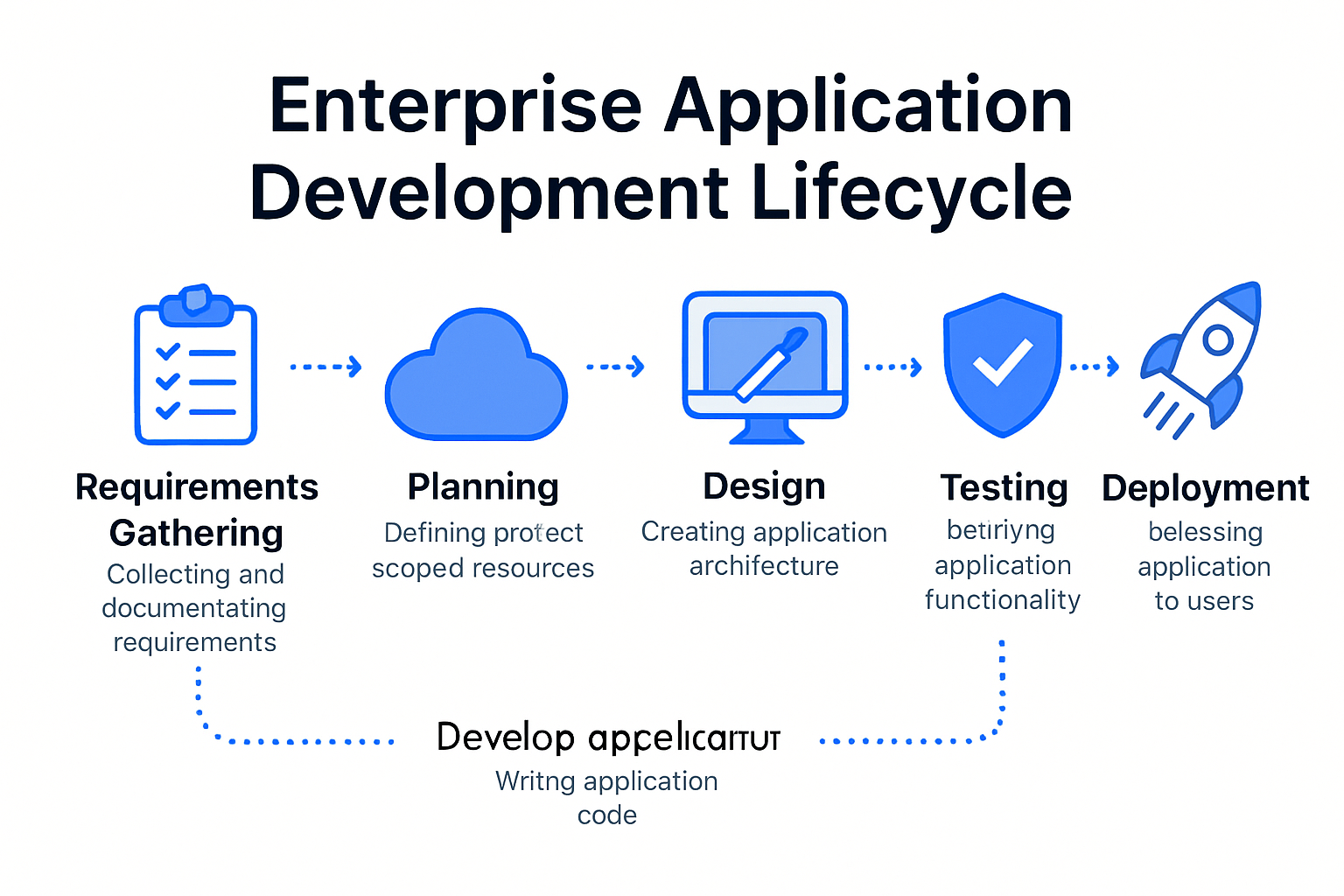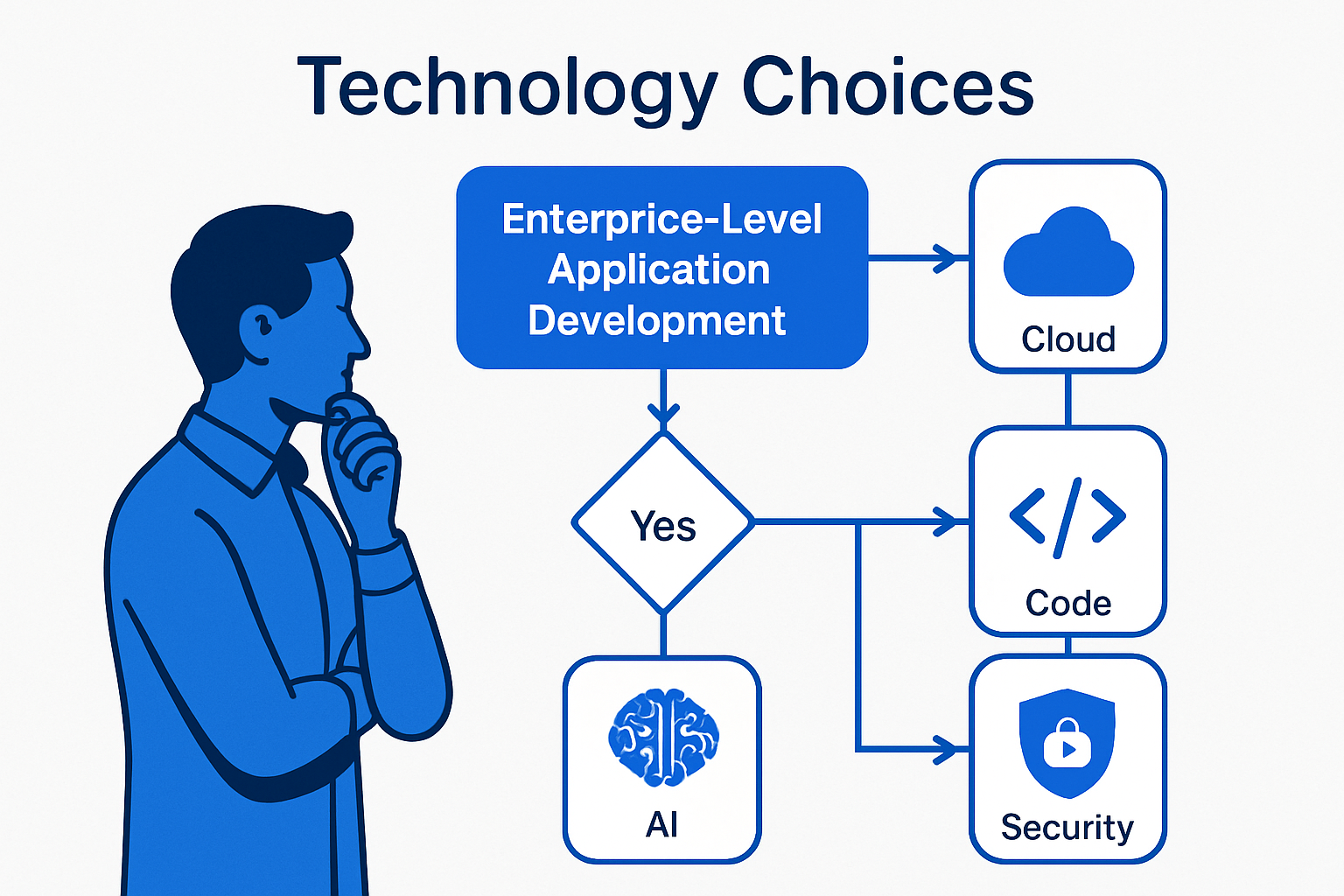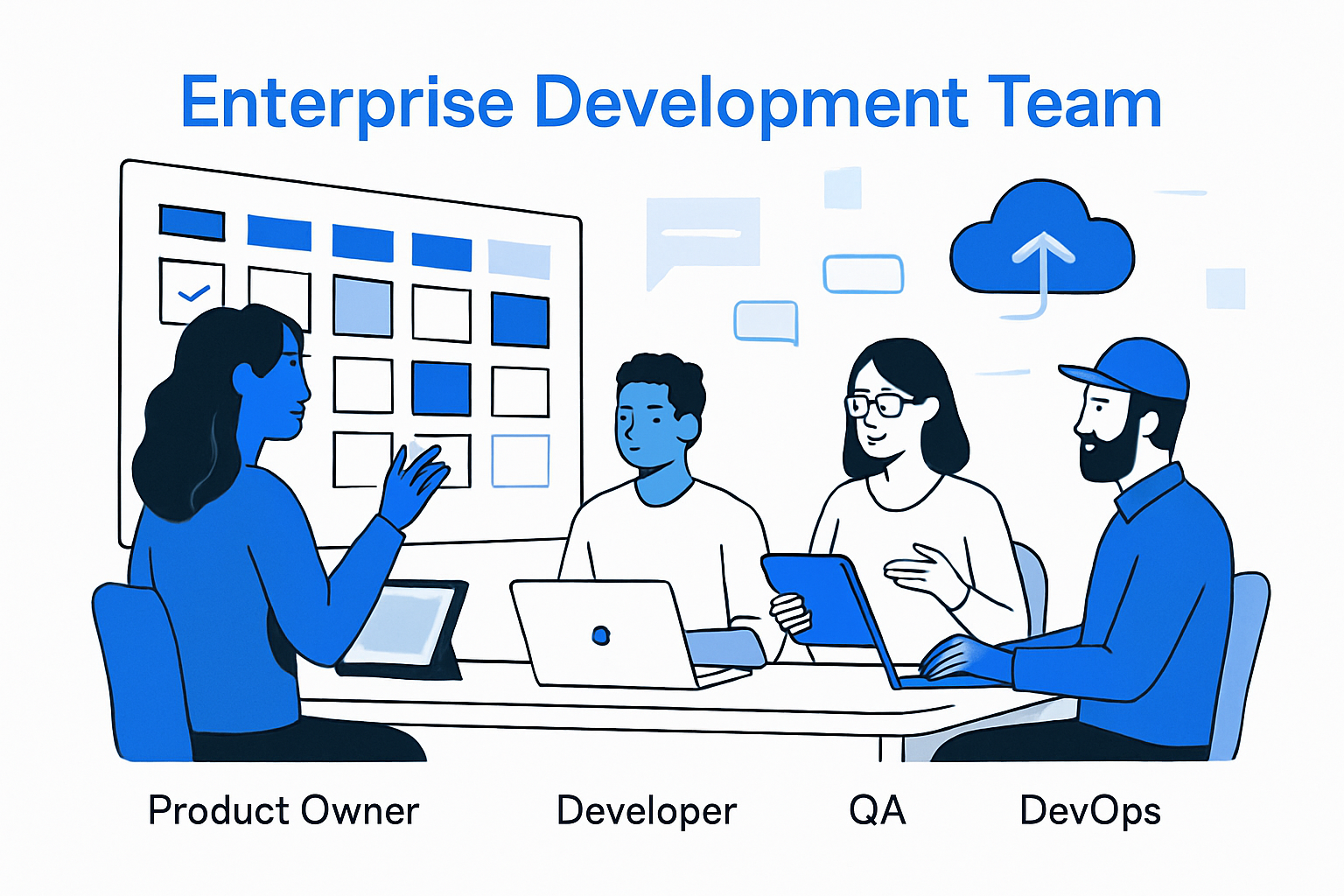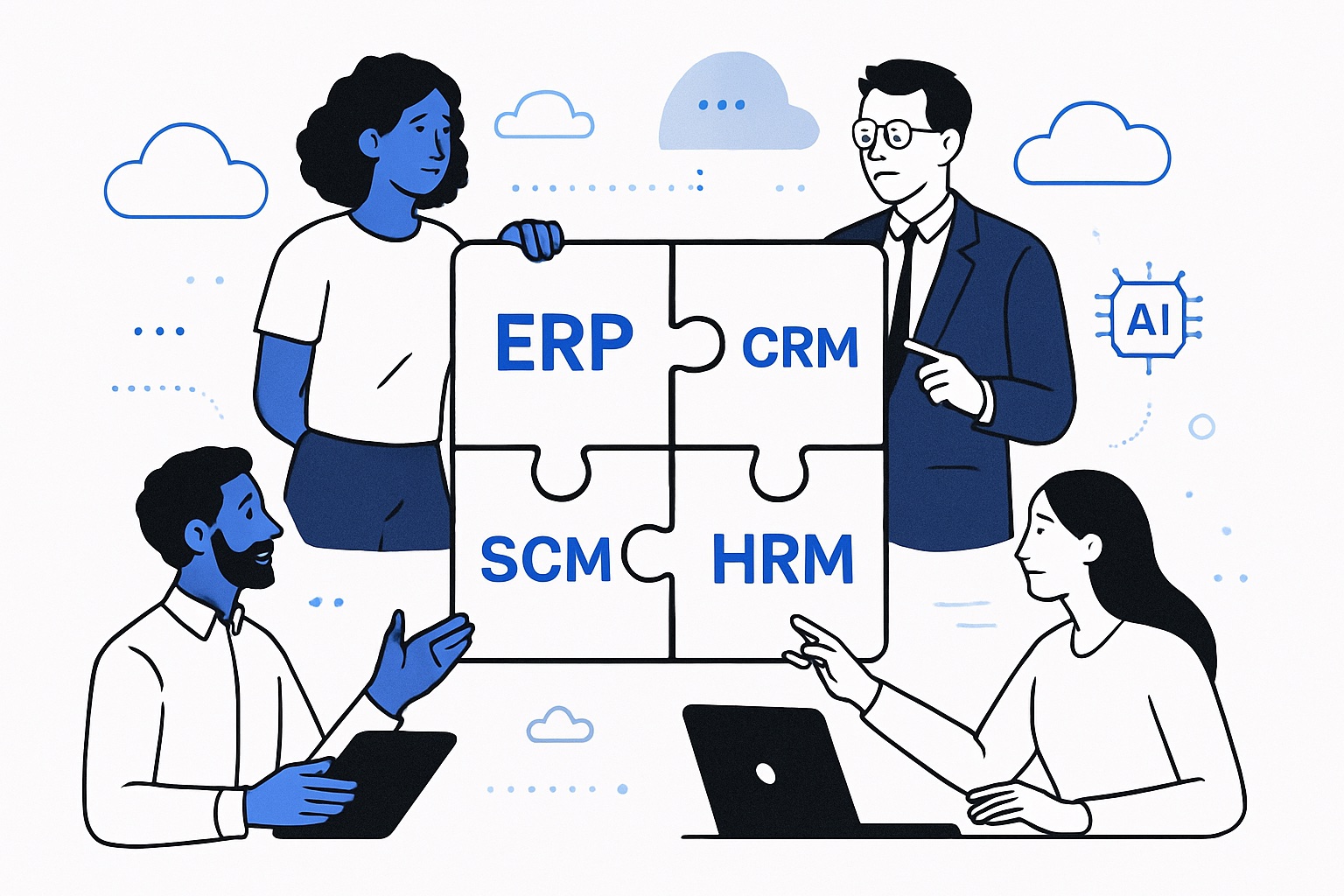Did you know enterprise software spending is set to reach $755 billion in 2025? As organizations race to innovate, enterprise level application development has become the backbone of digital transformation. Yet, building robust, scalable solutions is more complex than ever.
This guide demystifies the journey—covering every phase from planning to launch, technology options, team structures, and best practices. Discover proven strategies and emerging trends that power tomorrow’s enterprises, and equip your business with a roadmap for success.
Understanding Enterprise Level Application Development
Enterprise level application development is rapidly evolving, reshaping how organizations operate and compete in 2025. To navigate this landscape, it’s essential to understand what sets these applications apart, the unique challenges they pose, the tangible business impact they deliver, and the trends redefining the future.
Defining Enterprise Applications
In 2025, enterprise applications are robust, large-scale software systems designed to support critical business operations. Unlike consumer or SMB apps, these platforms handle vast user bases, complex workflows, and sensitive data. Typical examples include ERP (Enterprise Resource Planning), CRM (Customer Relationship Management), SCM (Supply Chain Management), and HRM (Human Resource Management) systems.
What defines these solutions? Key attributes include scalability to support growth, reliability to ensure uptime, ironclad security, and seamless integration with other business tools. Enterprise level application development must prioritize these qualities to deliver value and longevity.
Unique Challenges of Enterprise Development
The complexity of enterprise environments presents unique hurdles. Enterprise level application development must address diverse user needs, from executives to frontline staff, often across multiple regions and languages.
Security and regulatory compliance (GDPR, HIPAA) are non-negotiable. Integrating new applications with legacy systems and third-party services adds further layers of challenge. Customization is expected, demanding flexible architectures and ongoing support to keep pace with evolving requirements.
Business Impact and ROI
Enterprise level application development drives measurable business outcomes. Modern enterprise apps streamline operations, reduce manual effort, and unlock new efficiencies. Digital transformation initiatives among Fortune 500 companies have demonstrated dramatic improvements in productivity and cost savings.
According to Gartner, global enterprise software spending is projected to hit $755 billion in 2025. These investments pay off by enabling smarter decision-making, faster response to market changes, and sustainable growth.
Evolving User Expectations
Today’s enterprise users expect the same intuitive, seamless experiences they enjoy in consumer apps. Enterprise level application development must deliver user-centric interfaces, mobile-first access, and omnichannel support.
Personalization is a growing demand, with AI-driven features tailoring workflows and insights to individual needs. As remote and hybrid work models persist, accessibility, localization, and responsive design are more critical than ever.
Key Trends Shaping 2025
Several trends are transforming enterprise level application development. No-code and low-code platforms are democratizing app creation, making it faster and more accessible. AI and automation are enhancing analytics, process efficiency, and personalization.
Cloud-native architectures and microservices are now standard, supporting agility and scalability. For more on these pivotal changes influencing the industry, see Low-Code/No-Code Development Trends. Staying ahead means embracing these innovations and building systems ready for tomorrow’s demands.
The Enterprise Application Development Lifecycle: Step-by-Step
Navigating the enterprise level application development lifecycle requires a strategic, phased approach. Each stage builds the foundation for scalable, secure, and high-performing enterprise solutions. Let’s break down the essential steps that guide successful digital transformation projects in 2025.

Step 1: Requirements Gathering & Scoping
Every enterprise level application development project starts with a deep dive into business needs. Teams conduct stakeholder interviews, map existing processes, and document pain points.
Defining clear KPIs and success metrics is crucial for aligning expectations. For example, when scoping a global HRM system, teams gather input from HR leaders, regional managers, and end-users to capture diverse requirements.
This early investment ensures the solution will support complex workflows and scale as the enterprise grows. The output: a detailed project scope, prioritized feature list, and a shared vision for success.
Step 2: Solution Architecture & Technology Selection
Once requirements are clear, the next step in enterprise level application development is designing the solution architecture. Organizations evaluate options: custom code, no-code, or hybrid approaches depending on flexibility and speed.
Choosing between cloud, on-premises, or hybrid deployment hinges on scalability, compliance, and business goals. Security protocols and regulatory needs (like GDPR or HIPAA) must be factored in from the start.
Staying updated on enterprise application development trends in 2025—like microservices, AI, and cloud-native tech—helps teams future-proof their solutions and maintain a competitive edge.
Step 3: UX/UI Design & Prototyping
User experience is a top priority in enterprise level application development. Designers use tools like Figma, Sketch, or Adobe XD to create wireframes and interactive prototypes.
Early user testing with real employees helps validate workflows and interfaces. For global enterprises, multi-language support and accessibility are essential.
A prototype of an international dashboard, for instance, enables feedback from distributed teams before full-scale development begins. This iterative approach reduces costly redesigns and boosts user adoption.
Step 4: Development & Integration
With designs approved, development moves forward using agile methodologies. Sprint planning ensures rapid iteration and regular stakeholder reviews, keeping enterprise level application development on track.
API-first strategies and microservices allow for modular, scalable builds. Integration with existing systems—like SAP or Salesforce—is handled through robust APIs and middleware.
Building modular features enables phased rollouts, minimizing disruption and simplifying future updates. This flexibility supports evolving business needs and continuous improvement.
Step 5: Testing, QA, and Compliance
Rigorous testing is non-negotiable in enterprise level application development. Teams combine automated and manual tests to ensure functionality, performance, and security.
Security audits, penetration testing, and compliance verification (such as ISO or SOC2) protect sensitive data and meet regulatory obligations.
Preventing data breaches is a top concern—thorough QA processes catch vulnerabilities early. This phase also includes performance tuning to guarantee reliability at scale.
Step 6: Deployment, Training & Change Management
The final step in enterprise level application development is seamless deployment. CI/CD pipelines enable zero-downtime releases and smooth transitions from staging to production.
Comprehensive user training, clear documentation, and ongoing support drive adoption. Change management strategies, like staged rollouts and feedback loops, help employees adapt to new workflows.
A successful launch combines technical excellence with human-centered adoption, ensuring the enterprise realizes the full value of its digital investment.
Technology Choices for Enterprise Application Development
Selecting the right technology stack is a pivotal decision in enterprise level application development. The landscape in 2025 is more diverse than ever, with organizations balancing speed, security, scalability, and compliance. Let’s break down the main technology options shaping the future of enterprise solutions.

Custom Code vs. Low-Code/No-Code Platforms
Enterprises are increasingly weighing traditional custom coding against the rapid rise of low-code/no-code solutions. Custom code offers deep flexibility and control, but often comes with higher costs, longer timelines, and greater risk of technical debt. In contrast, low-code/no-code platforms empower business users and IT teams to deliver solutions faster and more affordably.
Here’s a quick comparison:
FeatureCustom CodeLow-Code/No-CodeSpeedSlower5x FasterFlexibilityUnlimitedHigh (with limits)CostHighLowerScalabilityCustomizablePlatform-dependent
According to Forrester, 70% of companies will adopt low-code by 2025. For a deeper dive into why this shift is happening, see No-code for enterprise applications. The right choice for enterprise level application development depends on project needs, regulatory demands, and available expertise.
Cloud-Native, On-Premises, and Hybrid Solutions
Enterprise level application development in 2025 is cloud-first, but not cloud-only. Public cloud platforms like AWS, Azure, and Google Cloud enable rapid scaling, resilience, and global reach. However, some industries—especially finance, healthcare, and government—still require on-premises or hybrid deployments for data residency and compliance.
Hybrid solutions are gaining traction, blending the agility of cloud with the security and control of on-premises infrastructure. This approach allows organizations to keep sensitive workloads local while leveraging the cloud for everything else. The right deployment model for enterprise level application development should align with compliance, performance, and integration needs.
Integrating AI and Automation
AI and automation are now core components of enterprise level application development. AI-driven features such as predictive analytics, natural language processing, and intelligent document processing are enhancing business processes across industries. Robotic Process Automation (RPA) is streamlining repetitive tasks, freeing up teams for higher-value work.
For example, AI-powered chatbots provide 24/7 support, while machine learning algorithms optimize supply chain operations. Integrating these advanced technologies requires careful planning to ensure security, scalability, and seamless user experiences within enterprise level application development.
Security, Compliance, and Data Governance
Security is non-negotiable in enterprise level application development. Modern applications must comply with a complex web of regulations, from GDPR to HIPAA and beyond. Implementing robust security frameworks, such as zero-trust architectures and end-to-end encryption, is essential.
Data governance also plays a critical role. Enterprises must manage data privacy, ensure integrity, and enforce access controls across jurisdictions. A proactive approach to security and compliance protects both the organization and its customers, making it a cornerstone of successful enterprise level application development.
Building and Managing High-Performance Enterprise Development Teams
Building a high-performance team is the cornerstone of successful enterprise level application development. As application complexity grows, the structure and management of your development team can make or break your project’s success.

Key Roles and Team Structures
A robust enterprise level application development team brings together a diverse mix of expertise. Key players include:
RoleResponsibilityProduct OwnerDefines vision and prioritiesSolution ArchitectDesigns scalable system architectureDevelopersBuild and maintain application featuresQA EngineersEnsure quality and complianceDevOps EngineersManage deployment and automationSecurity SpecialistsSafeguard data and infrastructure
Many enterprises choose cross-functional teams for flexibility, while others opt for specialized units for large-scale projects. The matrix team structure, where members report to both project and functional managers, is popular for global initiatives. For a detailed guide on structuring and managing teams, explore building effective development teams.
Agile, DevOps, and CI/CD Practices
Agile methodologies, such as Scrum and Kanban, have become essential in enterprise level application development. These frameworks ensure adaptability and continuous delivery, even in complex enterprise environments.
DevOps practices break down silos between development and operations, streamlining workflows and boosting collaboration. Continuous Integration and Continuous Deployment (CI/CD) pipelines automate testing and releases, reducing errors and speeding up delivery. The result? Faster time-to-market and the ability to respond rapidly to business needs.
Collaboration and Communication Tools
Success in enterprise level application development hinges on seamless communication. Distributed and hybrid teams rely on powerful tools, including:
Best practices involve setting clear communication protocols and encouraging transparency. For multi-location projects, real-time collaboration ensures everyone stays aligned, minimizing misunderstandings and delays.
Talent Acquisition and Retention
Finding and retaining top talent is one of the biggest challenges in enterprise level application development. Sourcing specialized developers with expertise in security, cloud, and automation can be tough.
To bridge the gap, enterprises invest in upskilling programs and foster a culture of continuous learning. According to Gartner, 64% of CIOs cite talent gaps as a top challenge heading into 2025. Prioritizing professional growth and recognizing contributions help retain high performers and build resilient teams.
Best Practices and Future Trends in Enterprise Application Development
Staying ahead in enterprise level application development means embracing best practices while anticipating what’s next. As the digital landscape evolves, developers and business leaders must prioritize security, flexibility, and sustainability. Let’s explore the essential strategies shaping the future of enterprise software.
Security-First Development
Security is at the heart of every successful enterprise level application development project. Embedding robust security measures throughout the software development lifecycle is no longer optional—it's essential.
Teams now adopt zero-trust frameworks, ensuring every access point and user is authenticated and authorized. Proactive threat modeling helps identify vulnerabilities before they become issues. For example, integrating single sign-on (SSO) and multi-factor authentication (MFA) can drastically reduce unauthorized access risks.
By prioritizing security from day one, organizations build trust and minimize costly breaches. This proactive approach to enterprise level application development ensures compliance and resilience in an increasingly complex threat landscape.
Embracing Microservices and APIs
Modern enterprise level application development is moving away from monolithic architectures toward modular, API-driven design. Microservices break down large applications into manageable, independently deployable components.
This approach offers several benefits:
A compelling case study is the migration of traditional ERP systems to microservices, resulting in faster updates and simplified maintenance. Embracing APIs and microservices positions enterprise level application development teams to respond quickly to changing business needs.
AI, ML, and Automation Trends
AI and automation are redefining enterprise level application development, enabling smarter solutions and streamlined workflows. Enterprises increasingly leverage AI for personalized user experiences, predictive analytics, and intelligent process automation.
Emerging use cases include chatbots for customer support, predictive maintenance in manufacturing, and intelligent document processing. According to IDC, 85% of enterprises plan to increase AI investments by 2025. To learn more about how AI is transforming enterprise systems, see AI's Role in Modern Enterprises.
Integrating AI tools within enterprise level application development projects not only enhances efficiency but also unlocks new business value.
Sustainable and Green IT Practices
Sustainability is becoming a core pillar of enterprise level application development. Organizations now prioritize energy-efficient cloud deployments and serverless architectures to reduce their carbon footprint.
Key practices include:
For instance, migrating workloads to energy-efficient cloud providers has helped global enterprises achieve significant reductions in power usage. Green IT isn’t just good for the planet—it also leads to cost savings and improved brand reputation.
Preparing for What’s Next: Adaptive Enterprise Applications
Future-ready enterprise level application development means building systems that can adapt to change. Modular design and low-code platforms are empowering teams to iterate quickly and respond to market shifts.
Continuous improvement loops, powered by user feedback and analytics, ensure applications evolve alongside business needs. Regular tech stack reviews and upgrades help future-proof core systems.
By embracing adaptability, organizations position themselves to thrive in a rapidly changing digital landscape. Enterprise level application development is no longer a one-time initiative but an ongoing journey toward innovation.
Now that you have a clearer picture of what it takes to build robust, scalable enterprise applications in 2025—and you’ve seen the game-changing impact of no-code and AI—you might be wondering what this could look like for your business. Whether you’re aiming to modernize legacy systems or create something entirely new, it helps to see real-world examples in action. Curious about what’s possible when you blend speed, flexibility, and innovation? Take a look at what other founders and enterprises have accomplished with Big House Technologies: See What We’ve Built for Founders Like You.




About Big House
Big House is committed to 1) developing robust internal tools for enterprises, and 2) crafting minimum viable products (MVPs) that help startups and entrepreneurs bring their visions to life.
If you'd like to explore how we can build technology for you, get in touch. We'd be excited to discuss what you have in mind.
Other Articles
Discover the top 7 website app development company picks for 2025 Compare features pricing and trends to choose the best partner for digital success
Discover the complete 2025 app and software development guide. Explore trends, best practices, tools, and strategies to build successful, future-ready solutions.
Discover 10 game changing no code tools for SaaS founders in 2026 Compare features pricing and benefits to accelerate growth reduce costs and outpace rivals

